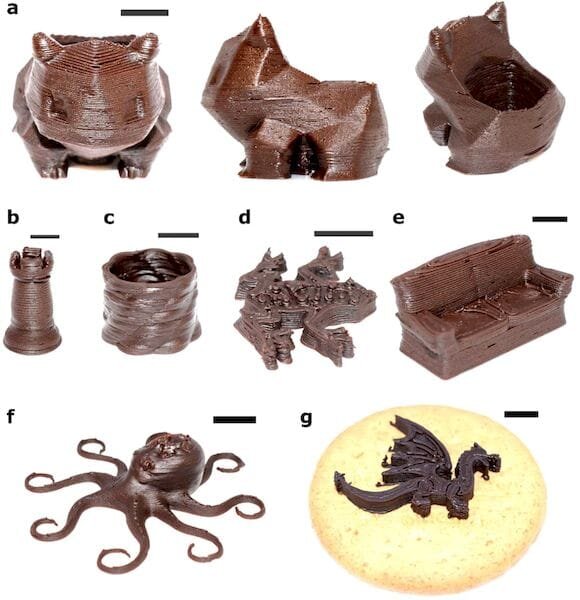![Sample chocolate 3D prints made with the Ci3DP process [Source: Scientific Reports]](https://fabbaloo.com/wp-content/uploads/2020/05/image-asset_img_5eb08e691d5c8.jpg) Sample chocolate 3D prints made with the Ci3DP process [Source: Scientific Reports]
Sample chocolate 3D prints made with the Ci3DP process [Source: Scientific Reports]
Researchers have developed a way to 3D print chocolate without the requirement of heating.
Chocolate has long been one of the most experimented food materials in 3D printing. At first, the material would appear to be an ideal substance for 3D printing, as it softens at relatively low temperatures and solidifies at room temperature. Just slightly heat it and extrude, and voila, you have a 3D printed chocolate object.
Chocolate 3D Printing
Not so fast. Chocolate turns out to be an extremely peculiar material. Its printing temperature range is quite narrow. Even worse, when 3D printed in softened form it takes a while to cool down, making it structurally challenging to print larger or more detailed structures.
There are also considerable concerns regarding the taste of the chocolate, as it can change depending on the degree and duration of heat exposure.
Now that may change due to the extensive work of researchers at the Singapore University of Technology and Design. They’ve managed to develop a process for 3D printing chocolate without the need for heat they call “Ci3DP”.
![The Ci3DP process to 3D print chocolate without heat [Source: Scientific Reports]](https://fabbaloo.com/wp-content/uploads/2020/05/image-asset_img_5eb08e6965869.jpg)
Modifying Chocolate For 3D Printing
The secret of Ci3DP seems to lie in the materials mix.
The researchers used a large number of combinations of chocolate syrup and cocoa powder to identify the best mix to allow successful extrusion at room temperature. They seem to have investigated factors such as layer adhesion and strength.
In fact, after reading through this paper I feel that I have now read the most detailed scientific exploration of chocolate I’ve ever seen, or will likely ever see again.
Here you can see one of their experiments involving changes to the concentration of cocoa and its effects on the 3D printed structures.
![Chocolate prints made with varying concentrations of cocoa powder [Source: Scientific Reports]](https://fabbaloo.com/wp-content/uploads/2020/05/image-asset_img_5eb08e69ad2f1.jpg)
The researchers suggest that the Ci3DP process would likely also work on other edible materials for 3D printing. All it would take would be to perform a similar analysis on the material by adding substances to beef up the structural properties.
Eating 3D Printed Chocolate
What is entirely unexplored in the paper, however, seems to be the taste factor, which is incredibly important for objects intended to be eaten.
While reading the paper I often wondered what a chocolate chef might feel, having observed some scientists mixing in seemingly random syrups and cocoa powder into a chocolate paste. Would they even consider the result to be chocolate?
This remains to be seen.
Should the Ci3DP process be commercialized, we could see many other food materials be certified for use in a 3D printer. By combining several different food materials in a single print job, it could be possible to 3D print simple food dishes.
But would anyone eat them?

